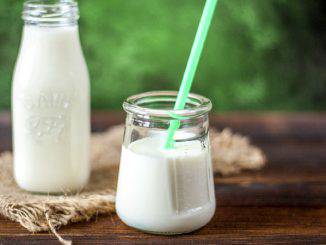
If you’re considering dabbling in fermentation, one of the healthiest and most flavorful options is milk kefir.
Milk kefir is a delicious, tart drink known for its probiotic benefits – which can aid digestion, strengthen your immune system, and more – that has been around for centuries. And luckily, making milk kefir is easier than ever before.
The only problem? It still takes time. As with any fermentation process, milk kefir requires a few days of fermenting to create its signature flavor and texture – but what if you don’t have that much time? Fortunately, there are a few tricks that you can use to speed up the process and get a delicious glass of milk kefir in no time.
In this blog post, we’ll share our guide to making milk kefir faster – so you can enjoy the health benefits sooner! We’ll start by discussing the basics of milk kefir and the factors that impact fermentation time, then move on to our tips for speeding up the process. We’ll also provide advice on how much milk kefir to make at once and how to store it properly – so you can enjoy this probiotic powerhouse as often as you’d like. So let’s get started – and learn all about milk kefir, making, and fermentation time!
What is The Typical Fermentation Time for Milk Kefir?
The fermentation time for milk kefir can vary depending on various factors such as temperature, the number of kefir grains used, and personal preference for taste and consistency. Generally, milk kefir is fermented for about 24 to 48 hours.
Fermenting milk kefir for a shorter time, around 24 hours, typically results in a milder and less tangy flavor. The longer fermentation time, up to 48 hours, allows for a stronger and more tangy flavor to develop.
It’s important to note that the fermentation time can also be influenced by environmental conditions. Warmer temperatures can speed up the fermentation process, while cooler temperatures can slow it down. It’s a good idea to monitor the kefir during the fermentation process and taste it periodically to determine when it has reached the desired flavor and consistency for your preference.
Generally, you should start tasting the kefir after 24-48 hours for a milder flavor, or wait up to a week for a more sour taste.
As we already said, the temperature of the room also affects the fermentation time. If the temperature is too warm, the fermentation will happen too quickly, and if it’s too cold, it may take much longer. Room temperature is usually ideal for making milk kefir, as it usually takes 1-2 days to ferment.
When Do You Need to Shorten the Fermentation Time?
Sometimes, you may need to shorten the fermentation time to get the desired flavor of your milk kefir.
For instance, if you prefer a milder flavor, you can shorten the fermentation time by a couple of hours. On the other hand, if you prefer a more sour taste, you can let it ferment a few hours longer. However, it’s important to note that ending the fermentation too soon can result in less probiotic content and a more watery texture.
So, if you’re looking for maximum health benefits, it’s best to let it ferment as long as possible.
What is Overfermented Kefir and How to Avoid Over-fermentation?
Over-fermented kefir refers to kefir that has been fermented for an extended period, resulting in a sour taste, a thicker consistency, and potentially a separation of whey. While some people enjoy the stronger flavor of over-fermented kefir, others may find it too tangy or intense.
To avoid over-fermenting your kefir, here are some tips:
- Monitor the fermentation time: Keep track of the fermentation time and start tasting the kefir after 24 hours. Check its flavor and consistency regularly to find the optimal fermentation period for your preference.
- Adjust the number of kefir grains: The number of kefir grains used can impact the fermentation time. Using a higher ratio of kefir grains to milk can accelerate the fermentation process. If you consistently notice over-fermentation, try reducing the number of kefir grains used or increasing the quantity of milk in the fermentation vessel.
- Control the temperature: Higher temperatures can speed up fermentation, while lower temperatures can slow it down. To prevent over-fermentation, ensure that the kefir is not left in a warm environment for too long. If your surroundings are consistently warm, consider reducing the fermentation time or finding a cooler spot for the fermentation process.
- Taste regularly: Tasting the kefir during the fermentation process is the best way to determine its readiness. Start tasting after 24 hours and continue checking the flavor and consistency until you reach the desired result. Once the kefir reaches a taste and texture you enjoy, promptly strain and refrigerate it to slow down further fermentation.
Remember that the fermentation process can vary based on personal preferences, environmental factors, and the specific characteristics of the kefir grains you are using. By monitoring the fermentation time, adjusting kefir grain quantity, controlling temperature, and regularly tasting the kefir, you can avoid over-fermentation and achieve the desired flavor and consistency.
Is Fermenting Kefir in the Refrigerator a Better Option?
Fermenting kefir in the refrigerator is not typically recommended because the colder temperatures can significantly slow down the fermentation process. Kefir grains thrive in a slightly warmer environment, usually around room temperature, to ferment the milk effectively.
Fermenting kefir at room temperature allows the beneficial bacteria and yeast present in the kefir grains to metabolize the lactose in the milk, producing lactic acid and other compounds that contribute to the characteristic flavor and texture of kefir.
However, if you need to slow down the fermentation process for some reason, such as if you’re going on vacation or have excess kefir grains, fermenting kefir in the refrigerator can be an option. The colder temperature will slow down the fermentation, but it will not completely halt it. The kefir will continue to ferment at a much slower rate, which can help extend its shelf life.
It’s important to note that fermenting kefir in the refrigerator will result in a significantly slower fermentation process, potentially taking several days to reach the desired flavor and consistency. So, if possible, it is generally recommended to ferment kefir at room temperature for optimal results.
On the other hand, fermenting kefir in the refrigerator favors the development of bacteria at the expense of yeasts. This ofter makes a thicker, smoother, and better-tasting kefir brew.
My Kefir is Over-fermented and Has Separated. What Can I Do?
If your kefir is over-fermented and has separated (with the whey separating from the curds), here’s what you can do:
- First of all, stir your kefir brew. In 99% of the cases, this solves the problem and your kefir will again be smooth and creamy.
However, if that doesn’t work for you … - Strain the kefir: Use a fine-mesh strainer or cheesecloth to separate the curds and whey. Place the strainer over a bowl or container to collect the whey. Gently pour the over-fermented kefir into the strainer, allowing the whey to drain out while the curds remain in the strainer.
- Save the whey: The whey that drains out can be collected and used in various other culinary applications. It is rich in probiotics and can be added to smoothies, used as a starter for lacto-fermented vegetables, or used in baking recipes that call for whey.
- Adjust the consistency (optional): If the curds are too thick for your liking, you can add some fresh milk to the strained kefir and gently stir to achieve the desired consistency. This can help dilute the curds and make the kefir smoother.
- Store in the refrigerator: Transfer the strained kefir to a clean glass jar or airtight container. Seal it tightly and store it in the refrigerator. Refrigeration slows down the fermentation process, allowing the kefir to stabilize.
- Use in recipes: Over-fermented kefir can still be used in various culinary applications. You can use it in smoothies, as a base for salad dressings, in baking recipes, in making cheese, or as a substitute for buttermilk in various recipes.
It’s worth noting that over-fermented kefir may have a stronger and tangier flavor compared to kefir fermented for a shorter period. Adjust the amount of kefir you consume based on your preference and tolerance for the stronger taste.
To prevent future over-fermentation, consider reducing the fermentation time or adjusting the number of kefir grains used for fermentation. Regularly monitoring the kefir during fermentation and tasting it can help you achieve the desired flavor and consistency.
My Kefir Doesn’t Ferment Even After Two Full Days. What To Do?
If your kefir doesn’t ferment even after two full days, there are a few things you can try to troubleshoot the issue:
- Check the temperature: Ensure that the kefir is fermenting at an appropriate temperature. Kefir ferments best at around room temperature, ideally between 68°F to 78°F (20°C to 26°C). If the environment is too cold, consider moving the fermentation vessel to a warmer spot or using a fermentation heater or wrap to maintain the desired temperature.
- Assess the kefir grains: Examine the kefir grains to ensure they are healthy and active. If the grains have become sluggish or are not fermenting properly, they may need some revitalization. Try rinsing the kefir grains with non-chlorinated water, such as spring water or filtered water, and then restarting the fermentation process with fresh milk.
- Adjust the milk-to-grain ratio: If the kefir grains are not fermenting the milk within the expected time frame, you can try adjusting the ratio of milk to kefir grains. Increase the amount of kefir grains used for a given quantity of milk. This will provide more microbial activity and potentially speed up the fermentation process.
- Use fresh milk: Ensure that you are using fresh milk for the fermentation. Raw or pasteurized milk is generally preferred, as ultra-pasteurized milk may have fewer beneficial microbes, which can affect the fermentation process.
- Give it more time: In some cases, kefir may require more than two days to ferment, particularly if the ambient temperature is cooler or the kefir grains are less active. Consider extending the fermentation time and monitoring the kefir closely until it reaches the desired taste and consistency.
- Seek assistance: If you have tried the above steps and your kefir is still not fermenting properly, it may be helpful to seek advice from experienced kefir enthusiasts or communities. They can provide specific guidance based on their own experiences and help troubleshoot the issue further.
Remember that kefir fermentation can vary depending on numerous factors, including temperature, milk quality, kefir grain health, and personal preferences. Experimenting and making adjustments can help you achieve the desired results with your kefir fermentation process.
Why Make Milk Kefir at Home?
Milk kefir is a traditional probiotic-rich beverage that has been around for centuries. It’s made using kefir grains, which are cultures of beneficial bacteria and yeast that ferment milk into a tart, tangy, and slightly carbonated drink. Because of its probiotic content, milk kefir has numerous health benefits, such as aiding digestion, improving nutrient absorption, and strengthening the immune system.
Making milk kefir at home is the best way to get all these benefits, as store-bought versions may not have the same probiotic content as homemade versions. Plus, it’s surprisingly easy to make.
All you need are milk kefir grains, milk, and a jar – and you can start making kefir at home.
Milk Kefir Recipe Brewing Tips
To make milk kefir at home, the first thing you need to do is acquire milk kefir grains. These are cultures of beneficial bacteria and fungi that ferment milk and turn it into a tart, tangy, and slightly carbonated drink. Once you have the grains, the process is quite simple.
First, you add the grains to a jar full of milk, and let it sit for 1-2 days – or longer depending on your preference. The next step is to strain out the grains and move the kefir into a bottle or jar. The grains can be reused, and the milk kefir can be stored in the refrigerator for up to two weeks. After that, you can drink the kefir straight, or use it in other recipes like smoothies or baking.
Finally, Some Milk Kefir Flavoring Suggestions
Once you’ve mastered the basics of making milk kefir, you may want to experiment with different flavors.
There are lots of ways to flavor milk kefir, such as adding fresh or frozen fruits, honey, spices, or herbs. You can also blend the kefir with other ingredients like yogurt, nut butter, or cocoa powder. The possibilities are nearly endless when it comes to flavoring milk kefir, so don’t be afraid to get creative. It’s a great way to turn a healthy beverage into a delicious treat that you’ll look forward to drinking every day.
Here is a list of typical flavorings that can be added to milk kefir to enhance its taste:
- Fresh or dried fruits: Berries (such as strawberries, blueberries, or raspberries), sliced bananas, diced mango, or any other fruit of your choice can be added to kefir. You can either blend them with kefir for a smoothie-like consistency or add them as small pieces for a fruity twist.
- Vanilla extract: A few drops of vanilla extract can add a pleasant and aromatic flavor to milk kefir.
- Cinnamon: Sprinkling a pinch of cinnamon powder into kefir can give it a warm and slightly sweet taste.
- Honey or maple syrup: Adding a drizzle of honey or maple syrup can provide natural sweetness and a hint of flavor to milk kefir.
- Cocoa or cacao powder: Mixing in cocoa or cacao powder can create a chocolatey flavor in milk kefir.
- Nut butter: Adding a spoonful of nut butter, such as almond butter or peanut butter, can give milk kefir a creamy and nutty taste.
- Fresh herbs: Fresh herbs like mint, basil, or lavender can infuse milk kefir with unique and refreshing flavors.
- Spices: Experiment with spices like ginger, cardamom, nutmeg, or turmeric to add depth and complexity to the flavor of milk kefir.
- Coconut flakes: Sprinkling shredded coconut or coconut flakes on top of milk kefir can provide a tropical taste and a slight crunch.
- Citrus zest: Grating the zest of citrus fruits like lemon, lime, or orange can add a tangy and fragrant twist to milk kefir.
Remember to add flavorings after the initial fermentation is complete, as they may interfere with the fermentation process. Additionally, taste and adjust the amount of flavoring based on your preference. Enjoy exploring different flavor combinations to find your favorite milk kefir variation!



